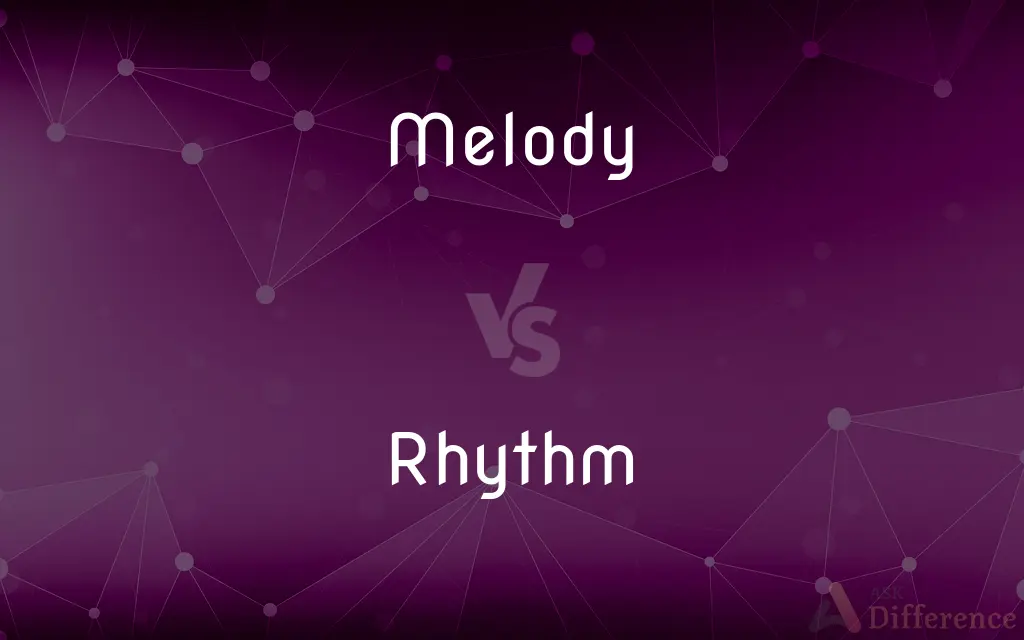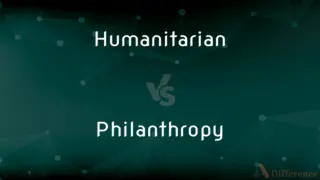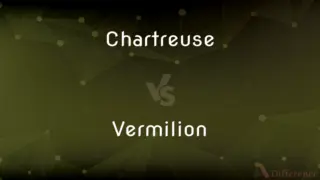Melody vs. Rhythm — What's the Difference?
By Fiza Rafique & Urooj Arif — Updated on March 12, 2024
Melody is a sequence of musical notes that are musically satisfying and often the main theme of a piece, while rhythm is the timing of music, encompassing beats, tempo, and the pattern of sounds and silences.

Difference Between Melody and Rhythm
Table of Contents
ADVERTISEMENT
Key Differences
Melody, often considered the "singing" part of music, consists of a series of notes that are perceived as a single entity, creating a memorable and tuneful aspect that is easy to recognize and often repeated throughout a piece. Rhythm, on the other hand, refers to the pattern in which sounds (notes, chords, and rests) are arranged in time, dictating the pace and flow of the music, which can vary from slow and steady to fast and complex.
Melodies are typically characterized by their tunefulness and the emotional responses they evoke, often following a structured progression with a clear beginning, climax, and resolution. Rhythms provide the foundational structure that supports the melody, using a combination of beats (the basic time unit) and tempo (the speed of the beats) to create patterns that can be simple or complex, repetitive or varied.
While melody is primarily horizontal in nature, representing a sequence of notes moving over time, rhythm is more vertical, focusing on how notes of different lengths and accents interact and coincide. This vertical arrangement contributes to the overall texture and complexity of the music.
The creation of melody involves the artful combination of pitch (the highness or lowness of a note) and duration, leading to phrases that can convey a wide range of emotions and ideas. Rhythm, conversely, relies on the timing and spacing of notes and silences, providing music with its pace and momentum, and often involves elements like meter (the grouping of beats into regular patterns) and syncopation (deliberate disruptions of the regular flow).
Both melody and rhythm are fundamental to music, with melody often being the most memorable aspect that listeners hum or recall, and rhythm providing the compelling drive that invites movement and dance. Their interplay is essential in crafting the emotional and dynamic qualities of a musical piece.
ADVERTISEMENT
Comparison Chart
Definition
Sequence of musical notes perceived as a single coherent structure
Timing and pattern of sounds and silences in music
Primary Role
Conveys the tune and main theme of a piece
Dictates the pace and flow of the music
Characteristics
Tuneful, emotional, structured progression
Beats, tempo, meter, syncopation
Nature
Horizontal (notes moving over time)
Vertical (interaction of notes and rests)
Emotional Impact
Evokes emotions and memories
Invites movement and dictates energy
Components
Pitch and duration of notes
Timing, spacing, and accentuation of notes and rests
Creation
Artful combination of pitches in a sequence
Arrangement of beats and tempo in patterns
Memorability
Often the most memorable aspect of music
Provides drive and compels movement
Compare with Definitions
Melody
A series of musical notes arranged in a pleasing sequence.
The melody of Happy Birthday is instantly recognizable.
Rhythm
The pattern of beats and silences in music.
The rhythm of the drumbeat set the pace for the song.
Melody
Characterized by its pitch and rhythm.
A good melody can evoke a wide range of emotions.
Rhythm
Dictates the tempo and flow of a musical piece.
A fast rhythm can energize the listener, while a slow rhythm can be calming.
Melody
The main theme or tune of a piece of music.
The symphony's melody was both haunting and beautiful.
Rhythm
Involves elements like beat, meter, and tempo.
The song's rhythm was characterized by its steady meter and upbeat tempo.
Melody
Often the part of the music that is sung or played as the main tune.
The violin played the melody over the orchestra's accompaniment.
Rhythm
Provides structure and momentum to music.
The syncopated rhythm added complexity to the jazz piece.
Melody
Can be simple or complex, depending on the arrangement of notes.
Folk songs often have simple, catchy melodies.
Rhythm
Can vary widely, from simple to highly complex patterns.
The rhythm of classical Indian music involves intricate patterns and variations.
Melody
Melody (from Greek μελῳδία, melōidía, "singing, chanting"), also tune, voice or line, is a linear succession of musical tones that the listener perceives as a single entity. In its most literal sense, a melody is a combination of pitch and rhythm, while more figuratively, the term can include successions of other musical elements such as tonal color.
Rhythm
Rhythm (from Greek ῥυθμός, rhythmos, "any regular recurring motion, symmetry"—Liddell and Scott 1996) generally means a "movement marked by the regulated succession of strong and weak elements, or of opposite or different conditions" (Anon. 1971, 2537).
Melody
A pleasing succession or arrangement of sounds.
Rhythm
Movement or variation characterized by the regular recurrence or alternation of different quantities or conditions
The rhythm of the tides.
Melody
Musical quality
The melody of verse.
Rhythm
The patterned, recurring alternations of contrasting elements of sound or speech.
Melody
A rhythmically organized sequence of single tones so related to one another as to make up a particular phrase or idea.
Rhythm
The patterning of musical sound, as by differences in the timing, duration, or stress of consecutive notes.
Melody
Structure with respect to the arrangement of single notes in succession.
Rhythm
A specific kind of such patterning
A waltz rhythm.
Melody
The leading part or the air in a composition with accompaniment.
Rhythm
A group of instruments supplying the rhythm in a band.
Melody
A poem suitable for setting to music or singing.
Rhythm
The pattern or flow of sound created by the arrangement of stressed and unstressed syllables in accentual verse or of long and short syllables in quantitative verse.
Melody
A sequence of notes that makes up a musical phrase
Rhythm
The similar but less formal sequence of sounds in prose.
Melody
A sweet or agreeable succession of sounds.
Lulled with sound of sweetest melody.
Rhythm
A specific kind of metrical pattern or flow
Iambic rhythm.
Melody
A rhythmical succession of single tones, ranging for the most part within a given key, and so related together as to form a musical whole, having the unity of what is technically called a musical thought, at once pleasing to the ear and characteristic in expression.
Rhythm
The sense of temporal development created in a work of literature or a film by the arrangement of formal elements such as the length of scenes, the nature and amount of dialogue, or the repetition of motifs.
Melody
The air or tune of a musical piece.
Rhythm
A regular or harmonious pattern created by lines, forms, and colors in painting, sculpture, and other visual arts.
Melody
A succession of notes forming a distinctive sequence;
She was humming an air from Beethoven
Rhythm
The pattern of development produced in a literary or dramatic work by repetition of elements such as words, phrases, incidents, themes, images, and symbols.
Melody
The perception of pleasant arrangements of musical notes
Rhythm
Procedure or routine characterized by regularly recurring elements, activities, or factors
The rhythm of civilization.
The rhythm of the lengthy negotiations.
Rhythm
The variation of strong and weak elements (such as duration, accent) of sounds, notably in speech or music, over time; a beat or meter.
Dance to the rhythm of the music.
Rhythm
A specifically defined pattern of such variation.
Most dances have a rhythm as distinctive as the Iambic verse in poetry
Rhythm
A flow, repetition or regularity.
Once you get the rhythm of it, the job will become easy.
Rhythm
The tempo or speed of a beat, song or repetitive event.
We walked with a quick, even rhythm.
Rhythm
The musical instruments which provide rhythm (mainly; not or less melody) in a musical ensemble.
The Baroque term basso continuo is virtually equivalent to rhythm
Rhythm
A regular quantitative change in a variable (notably natural) process.
The rhythm of the seasons dominates agriculture as well as wildlife
Rhythm
Controlled repetition of a phrase, incident or other element as a stylistic figure in literature and other narrative arts; the effect it creates.
The running gag is a popular rhythm in motion pictures and theater comedy
Rhythm
A person's natural feeling for rhythm.
That girl's got rhythm, watch her dance!
Rhythm
In the widest sense, a dividing into short portions by a regular succession of motions, impulses, sounds, accents, etc., producing an agreeable effect, as in music poetry, the dance, or the like.
Rhythm
Movement in musical time, with periodical recurrence of accent; the measured beat or pulse which marks the character and expression of the music; symmetry of movement and accent.
Rhythm
A division of lines into short portions by a regular succession of arses and theses, or percussions and remissions of voice on words or syllables.
Rhythm
The harmonious flow of vocal sounds.
Rhythm
The basic rhythmic unit in a piece of music;
The piece has a fast rhythm
The conductor set the beat
Rhythm
Recurring at regular intervals
Rhythm
An interval during which a recurring sequence of events occurs;
The neverending cycle of the seasons
Rhythm
The arrangement of spoken words alternating stressed and unstressed elements;
The rhythm of Frost's poetry
Rhythm
Natural family planning in which ovulation is assumed to occur 14 days before the onset of a period (the fertile period would be assumed to extend from day 10 through day 18 of her cycle)
Common Curiosities
Is rhythm more important than melody?
Neither is inherently more important; both rhythm and melody play crucial roles in defining the character and emotional impact of music.
What is melody in music?
Melody is a sequence of notes that are perceived as a single coherent entity, often forming the main theme or tune of a piece.
Can a musical piece exist without a melody?
Yes, some musical pieces focus primarily on rhythm and texture, creating an atmospheric or percussive effect without a distinct melody.
Can the melody and rhythm be the same in a song?
While they are distinct aspects, the melody of a song can have rhythmic qualities, and rhythms can be melodic, especially in genres where the two are closely intertwined.
What role does rhythm play in dance music?
In dance music, rhythm is fundamental, providing the beat and tempo that facilitate dancing and contribute to the music's overall energy.
How do musicians keep rhythm?
Musicians keep rhythm through internal timing, often aided by metronomes during practice, and by following the beat set by percussion instruments or conductors in ensemble settings.
How does melody convey emotion in music?
Melody conveys emotion through the choice and arrangement of pitches, their durations, and the way they move and resolve, creating a narrative or mood.
Can a song have multiple melodies?
Yes, a song can have multiple melodies, often seen in counterpoint music, where two or more melodies play simultaneously but independently.
How does rhythm affect music?
Rhythm affects music by dictating its pace, energy, and flow through patterns of beats, tempo, and the arrangement of sounds and silences.
What is the role of melody in instrumental music?
In instrumental music, the melody often serves as the main thematic element, carried by a lead instrument, guiding the piece's emotional and narrative flow.
How do composers create melodies?
Composers create melodies by artfully combining pitches and durations of notes, considering aspects like harmony, structure, and emotional expression.
Are there genres of music that focus more on rhythm?
Yes, genres like percussion music, techno, and some forms of dance and electronic music often emphasize rhythm over melody.
What makes a melody memorable?
A memorable melody typically has a clear, singable tune with a catchy sequence of notes and a coherent structure that resonates emotionally with listeners.
How do melody and rhythm work together in music?
Melody and rhythm work together to create the full expression of a musical piece, with melody providing the tune and narrative, while rhythm offers structure and momentum.
How is rhythm notated in music?
Rhythm is notated using a combination of notes, rests, and other symbols that indicate duration, timing, and the beat pattern in sheet music.
Share Your Discovery

Previous Comparison
Humanitarian vs. Philanthropy
Next Comparison
Chartreuse vs. VermilionAuthor Spotlight
Written by
Fiza RafiqueFiza Rafique is a skilled content writer at AskDifference.com, where she meticulously refines and enhances written pieces. Drawing from her vast editorial expertise, Fiza ensures clarity, accuracy, and precision in every article. Passionate about language, she continually seeks to elevate the quality of content for readers worldwide.
Co-written by
Urooj ArifUrooj is a skilled content writer at Ask Difference, known for her exceptional ability to simplify complex topics into engaging and informative content. With a passion for research and a flair for clear, concise writing, she consistently delivers articles that resonate with our diverse audience.
















































